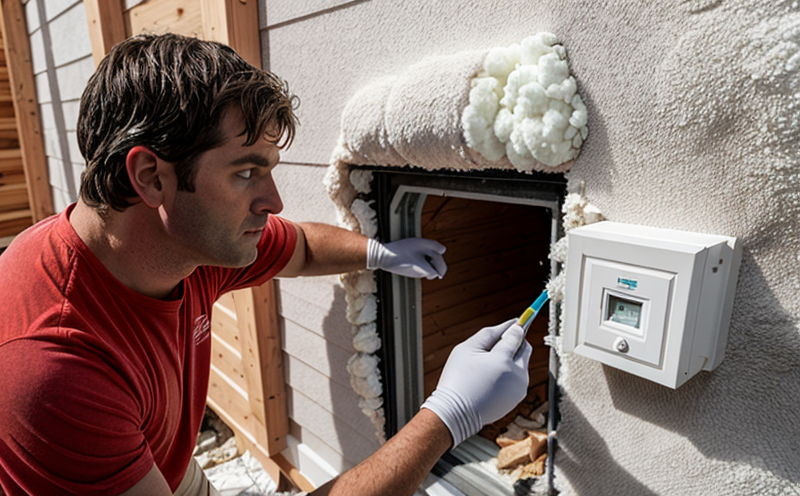EN 12667 Determination of Thermal Resistance
The European Standard EN 12667 is a cornerstone in assessing the thermal performance of insulating materials used in building and infrastructure projects. This standard provides a method for determining the thermal resistance (R-value) of insulation materials, which is crucial for ensuring that buildings meet energy efficiency requirements set by regulatory bodies.
The process involves measuring the heat flow through a standardized specimen under controlled conditions. The specimen is placed between two chambers with different temperatures maintained at known values. Heat loss across the material is measured using calorimetric techniques or other specified methods, such as guarded hot plate or guarded hot edge apparatus. This approach ensures that the thermal resistance can be accurately determined independent of external factors.
The standard specifies a series of test conditions aimed at replicating real-world scenarios where insulation products are typically used. These include various thicknesses, types of materials (fibrous, cellular foams, etc.), and installation methods. The precision and accuracy of these tests are paramount in ensuring that the results reflect actual performance under typical usage conditions.
Accurate determination of thermal resistance is essential for several reasons:
- Regulatory Compliance: Many countries have adopted standards based on EN 12667 to ensure that buildings meet energy efficiency targets. Non-compliance can result in penalties and reputational damage.
- Cost Savings: By ensuring insulation materials perform as expected, the need for additional heating or cooling is minimized, leading to lower operational costs over the lifecycle of a building.
- Environmental Impact Reduction: Improved thermal performance leads to reduced energy consumption and greenhouse gas emissions, aligning with global sustainability goals.
- Innovation: Testing per EN 12667 helps R&D teams refine materials and processes for better insulation, opening new avenues in green building technologies.
The method outlined in the standard is not only precise but also flexible enough to accommodate various types of insulating materials. This versatility makes it a valuable tool for both established manufacturers and startups aiming to innovate within the construction sector.
Understanding the nuances of EN 12667 allows stakeholders to make informed decisions about insulation choices, ensuring that projects are not only compliant but also optimized for energy efficiency and sustainability.
Why It Matters
The determination of thermal resistance using EN 12667 is critical in several aspects:
- Energy Efficiency: Accurate measurement ensures that insulation materials perform as expected, leading to reduced energy consumption and operational costs.
- Sustainability: Ensuring compliance with energy standards helps reduce the environmental impact of buildings by minimizing carbon footprints.
- Regulatory Compliance: Meeting standards like EN 12667 ensures that products meet regulatory requirements, avoiding potential legal issues and penalties.
- Quality Assurance: Rigorous testing provides assurance that materials will perform as intended throughout their lifecycle, enhancing customer satisfaction.
- Innovation: The standard encourages the development of new technologies and materials that can enhance insulation performance beyond current benchmarks.
- Economic Benefits: Improved thermal performance leads to lower utility bills, contributing positively to both residential and commercial property values.
- Longevity: Properly tested insulation ensures durability and longevity of the building structure, reducing maintenance costs over time.
The importance of EN 12667 cannot be overstated in today's context where sustainability and energy efficiency are key priorities across industries. By adhering to this standard, stakeholders can ensure that their projects meet both current standards and future requirements, paving the way for more efficient and sustainable construction practices.
Why Choose This Test
Choosing EN 12667 for determining thermal resistance offers several advantages:
- Precision: The standardized method ensures accurate measurement, providing reliable data that can be trusted by all stakeholders.
- Consistency: By following a consistent protocol, the results are repeatable and comparable across different laboratories and regions.
- Regulatory Compliance: Adherence to this standard is essential for meeting regulatory requirements in various countries around the world.
- Expertise: Partnering with a reputable laboratory ensures access to experienced personnel who understand the intricacies of the test methods.
- Technology: Advanced equipment and instrumentation used by leading laboratories provide precise measurements that are not possible with less sophisticated tools.
- Support Services
The EN 12667 method is recognized globally, making it a universally accepted standard. This global recognition ensures that the results are widely understood and accepted, facilitating smoother international collaborations and trade.
International Acceptance and Recognition
The EN 12667 standard has gained significant acceptance and recognition worldwide due to its robustness and reliability. It is widely adopted by countries that prioritize energy efficiency in building codes, such as the United Kingdom, Germany, France, and many others.
International standards like EN 12667 are crucial for ensuring consistency across borders. They provide a common language and methodology that can be understood and followed globally, enhancing collaboration among professionals from diverse backgrounds. This standardization is particularly important in projects involving international partnerships or exports to countries with stringent energy efficiency regulations.
The widespread acceptance of EN 12667 also contributes to the harmonization of testing practices across different regions. By adhering to this standard, laboratories and manufacturers can ensure that their products meet the highest quality standards regardless of location. This consistency is vital for maintaining market confidence and fostering trust among stakeholders.
The global recognition of EN 12667 extends beyond its practical applications in building and infrastructure testing. It also plays a significant role in promoting sustainable practices and reducing environmental impact, aligning with broader international efforts towards climate change mitigation.





